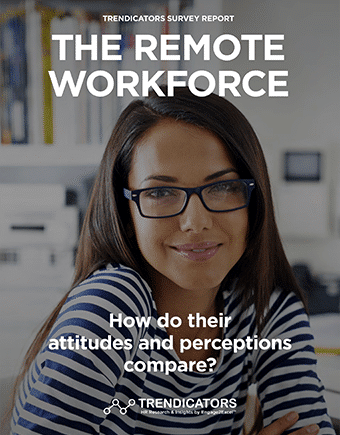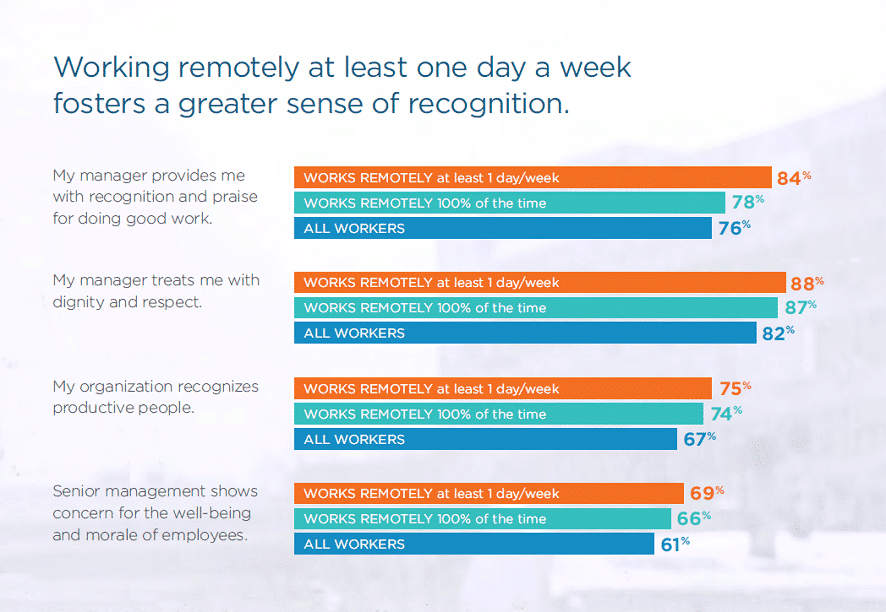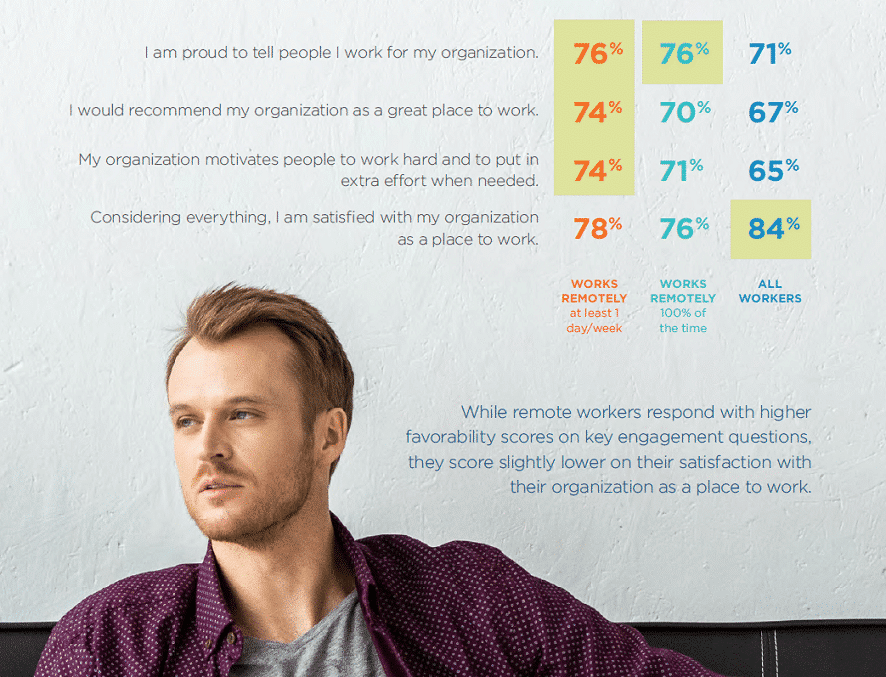The Remote Workforce

How does working remotely, or telework, impact the perceptions that influence engagement?
Teleworking has grown 115% in the past decade, according to the Society for Human Resources. However, in 2017, a number of large employers made headlines by abandoning their telework initiatives, citing the desire to improve communication, collaboration and teamwork. This move was surprising to many for two reasons:
- Nearly three-quarters of millennials express a desire to have more opportunities to work remotely1.
- Employers can save $11,000 per half-time telecommuter2.
Do employees who work remotely feel less recognized, exhibit lower engagement levels or experience less attention from their manager? To find out, we conducted a regression analysis on our 2018 survey of 5,000 employees nationwide. The results presented on the following pages may surprise you.
1. 2017 Deloitte Millennial Survey
2. Global Workplace Analytics
Survey Demographics
Number of Respondents: 5,000
Countries Represented: United States
Industries Represented: All major industries
Respondent Demographics: U.S. adult workers in all job types with proportionate representation of gender, age group and racial/ ethnic origin
Margin of Error: 95% confidence level +/- 1.5%
Trendicators is the research division of Engage2Excel, a leading provider of employee recognition, engagement survey and talent acquisition solutions. Trendicators provides original research, along with reports on insights and best practices from industry leaders and experts.
Download
 hbspt.cta.load(123973, '22501cb7-228b-4864-8d00-e009f31c5dcd', {});
hbspt.cta.load(123973, '22501cb7-228b-4864-8d00-e009f31c5dcd', {});

Download
 hbspt.cta.load(123973, '22501cb7-228b-4864-8d00-e009f31c5dcd', {});
hbspt.cta.load(123973, '22501cb7-228b-4864-8d00-e009f31c5dcd', {});
Overall, remote workers are more engaged than the average worker, with one exception.

Download
 hbspt.cta.load(123973, '22501cb7-228b-4864-8d00-e009f31c5dcd', {});
hbspt.cta.load(123973, '22501cb7-228b-4864-8d00-e009f31c5dcd', {});
Remote workers have stronger ties with managers for career development.
The most significant differences in perception exist on the topic of investment made by a manager in an employee’s growth and development. Employees who work remotely at least one day a week registered favorability scores that were 13% higher than those of all other employees, including those who work remotely 100% of the time and all workers.
My manager has made a personal investment in my growth and development:
WORKS REMOTELY at least 1 day/week: 66%
WORKS REMOTELY 100% of the time: 53%
ALL WORKERS: 53%
Surprisingly, remote workers have a slightly stronger belief in their organization’s future.
I believe that my organization has an outstanding future.
WORKS REMOTELY at least 1 day/week: 76%
WORKS REMOTELY 100% of the time: 76%
ALL WORKERS: 71%
In times of low unemployment, belief in the future of one’s organization is important. It is interesting that all employees who work remotely held slightly stronger beliefs in the future of their organization.
Download
 hbspt.cta.load(123973, '22501cb7-228b-4864-8d00-e009f31c5dcd', {});
hbspt.cta.load(123973, '22501cb7-228b-4864-8d00-e009f31c5dcd', {});
Job security and pay are important for all workers and highest among the remote workforce.
What do employees want most?
Our survey revealed that job security, as well as equitable pay and compensation, topped the list of what all employees want most. Those who work remotely 100% of the time scored higher in these two items than the two other groups.
JOB SECURITY:
WORKS REMOTELY at least 1 day/week: 28%
WORKS REMOTELY 100% of the time: 32%
ALL WORKERS: 25%
EQUITABLE PAY & COMPENSATION:
WORKS REMOTELY at least 1 day/week: 15%
WORKS REMOTELY 100% of the time: 20%
ALL WORKERS: 19%
Download
 hbspt.cta.load(123973, '22501cb7-228b-4864-8d00-e009f31c5dcd', {});
hbspt.cta.load(123973, '22501cb7-228b-4864-8d00-e009f31c5dcd', {});